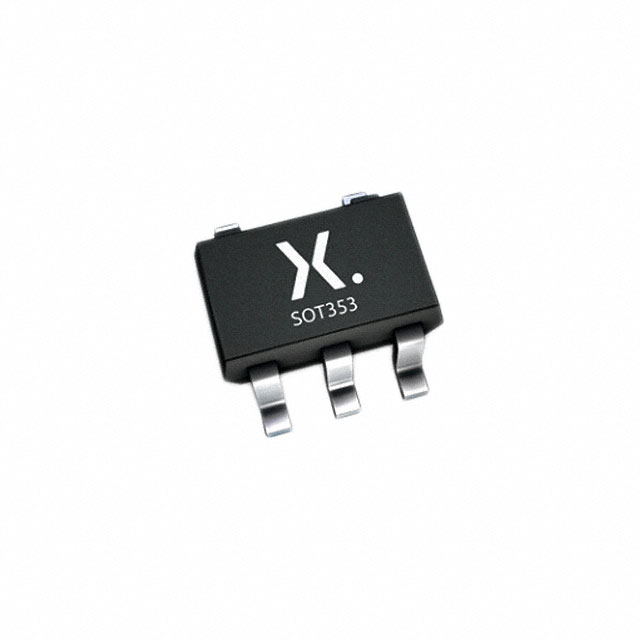Xem thông số kỹ thuật để biết chi tiết sản phẩm.

74HC1GU04GW,165
Basic Information Overview
- Category: Integrated Circuit (IC)
- Use: Logic Gate Inverter
- Characteristics: High-speed operation, low power consumption
- Package: SOT753 (SC-70-5)
- Essence: Single gate inverter
- Packaging/Quantity: Tape and Reel, 3000 pieces per reel
Specifications
- Supply Voltage Range: 2.0V to 6.0V
- Input Voltage Range: 0V to VCC
- Output Voltage Range: 0V to VCC
- Maximum Operating Frequency: 125 MHz
- Propagation Delay: 7 ns (typical)
Detailed Pin Configuration
The 74HC1GU04GW,165 has a total of 5 pins: 1. GND (Ground) 2. A (Input) 3. Y (Output) 4. NC (No Connection) 5. VCC (Power Supply)
Functional Features
- Single gate inverter with Schmitt-trigger input
- Provides logic level inversion with hysteresis
- Suitable for voltage level shifting applications
- High noise immunity due to Schmitt-trigger input
Advantages
- High-speed operation allows for efficient signal processing
- Low power consumption makes it suitable for battery-powered devices
- Small package size saves board space
- Wide supply voltage range enables compatibility with various systems
Disadvantages
- Limited number of gates available in a single package
- Not suitable for high-current applications
Working Principles
The 74HC1GU04GW,165 is based on CMOS technology, which uses complementary pairs of MOSFETs (Metal-Oxide-Semiconductor Field-Effect Transistors) to implement logic functions. The gate acts as an inverter, changing the input logic level to its complement at the output. The Schmitt-trigger input provides hysteresis, ensuring a clean and stable output even in the presence of noise or signal fluctuations.
Detailed Application Field Plans
- Voltage level shifting: The 74HC1GU04GW,165 can be used to convert logic levels between different voltage domains, allowing communication between systems with incompatible voltage levels.
- Signal conditioning: Its Schmitt-trigger input makes it suitable for applications where noise immunity is crucial, such as in sensor interfaces or digital communication systems.
- Clock signal generation: The inverter can be used to generate complementary clock signals with precise timing, essential in synchronous digital circuits.
Detailed and Complete Alternative Models
- SN74LVC1G04DBVR: Single gate inverter with similar specifications, available in SOT23-5 package.
- MC74VHC1GU04DTT1G: Single gate inverter with higher operating frequency, available in SOT353 package.
- CD74HCT04M96: Hex inverter with similar characteristics, available in SOIC-14 package.
This concludes the encyclopedia entry for the 74HC1GU04GW,165, providing an overview of its basic information, specifications, pin configuration, functional features, advantages and disadvantages, working principles, detailed application field plans, and alternative models.
Liệt kê 10 câu hỏi và câu trả lời thường gặp liên quan đến ứng dụng 74HC1GU04GW,165 trong giải pháp kỹ thuật
Sure! Here are 10 common questions and answers related to the application of 74HC1GU04GW and 165 in technical solutions:
1. What is the purpose of the 74HC1GU04GW? - The 74HC1GU04GW is a single unbuffered inverter gate that can be used for signal inversion or amplification in digital circuits.
2. What is the function of the 165 shift register? - The 165 is an 8-bit parallel-in/serial-out shift register that allows data to be shifted in serially and then outputted in parallel.
3. Can I use multiple 74HC1GU04GW inverters together? - Yes, you can connect multiple 74HC1GU04GW inverters in series to create larger logic gates or more complex digital circuits.
4. How do I connect the 165 shift register to my microcontroller? - The 165 shift register typically requires connections to the microcontroller's clock (CLK), data (DATA), and latch enable (LE) pins, as well as power and ground.
5. What is the maximum clock frequency supported by the 165 shift register? - The maximum clock frequency of the 165 shift register depends on various factors such as supply voltage and temperature, but it is typically around several megahertz.
6. Can I daisy-chain multiple 165 shift registers together? - Yes, you can connect multiple 165 shift registers in series to expand the number of inputs or outputs in your circuit.
7. Are there any limitations on the input voltage range of the 74HC1GU04GW? - The 74HC1GU04GW has a wide input voltage range, typically from 2V to 6V, making it compatible with various logic levels.
8. How much current can the 165 shift register sink/source? - The current sinking or sourcing capabilities of the 165 shift register depend on the specific model and operating conditions. Please refer to the datasheet for detailed information.
9. Can I use the 74HC1GU04GW and 165 together in a circuit? - Yes, you can use the 74HC1GU04GW as an inverter for the clock signal or other inputs to the 165 shift register, allowing for signal inversion or amplification within the circuit.
10. Are there any recommended decoupling capacitors for these components? - It is generally recommended to include decoupling capacitors near the power supply pins of both the 74HC1GU04GW and 165 to minimize noise and ensure stable operation. The specific values and placement should be determined based on the application and manufacturer's guidelines.
Please note that these answers are general and may vary depending on the specific requirements and datasheets of the components.

